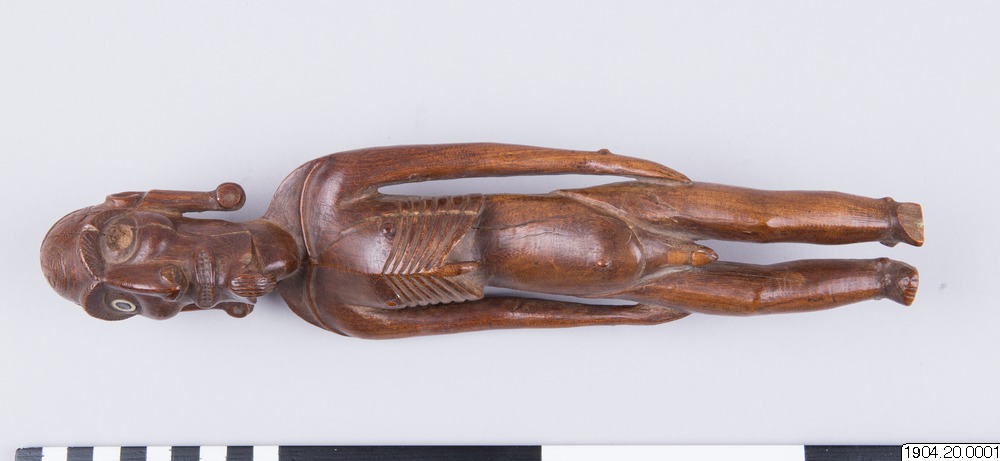| Typ <itemType> |
Objekt/föremål |
| Plats <presPlaceLabel> |
Oceanien, Påskön (Chile) |
| Beskrivning <itemDescription> |
|
| Publicerad text, engelska <itemDescription> |
-
A mo‘ai kavakava is a small wooden figure of a style originated by the Rapa Nui culture of Easter Island. Each figure resembles a standing, slightly stooped, male human with an emaciated body. The nam...
Visa hela
A mo‘ai kavakava is a small wooden figure of a style originated by the Rapa Nui culture of Easter Island. Each figure resembles a standing, slightly stooped, male human with an emaciated body. The name mo‘ai kavakava is formed from mo‘ai for the monumental monolithic human figures found on Easter Island and the word kavakava meaning ribs. Little is known about the cultural context of these figures although they are generally considered to be representations of starving ancestors or demons. It is believed these figures were worn hanging around the necks of men who took part in the ritual dances during public ceremonies. (Wikipedia, läst 2021)
Stäng
|
| Beskrivning / engelska <itemDescription> |
-
Male figure (moai kavakava). The figure is missing one eye. There is no perforation at the back of the figure for suspension, a feature noted on some other moai kavakava. An ornate abstract figure is ...
Visa hela
Male figure (moai kavakava). The figure is missing one eye. There is no perforation at the back of the figure for suspension, a feature noted on some other moai kavakava. An ornate abstract figure is carved on the head of the object.
Stäng
|
| Utställning / tidigare <itemDescription> |
|
| Utställning, del av / tidigare <itemDescription> |
|
| Referens, publicerad i <itemDescription> |
|
| Geografiskt namn / annat <itemDescription> |
|
| Land / engelska <itemDescription> |
|
| Geografiskt namn / annat <itemDescription> |
|
| Geografiskt namn / annat <itemDescription> |
|
| Geografiskt namn / annat <itemDescription> |
|
| Geografiskt namn / annat <itemDescription> |
|
| Geografiskt namn / annat <itemDescription> |
|
| Utställning, extern / tidigare <itemDescription> |
|
| Händelse <context> |
-
Ursprung i Påskön (Chile), Oceanien.
-
Förvärvad 1904 av Retzius, Gustaf.
-
Utställd 2020-09-26 - 2022-11-06 i Etnografiska museet, Stockholm av Human Nature.
|
| Material, engelska<itemMaterial> |
- wood
- obsidian
- bone
|
| Materialkategori<itemMaterial> |
- ben-horn
- trä
- sten-mineral
|
| Material<itemMaterial> |
- trä
- obsidian
- ben
|
| Nyckelord <itemKeyWord> |
-
1904.20.0001
-
GR.1
-
Rapa Nui
|
| Mått <itemMeasurement> |
-
Höjd: 32 cm.
-
Bredd: 8 cm.
-
Djup: 6 cm.
|
| Lokalt namn<itemName> |
- moai kavakava
|
| Sakord, engelska<itemName> |
- sculpture
- figure
|
| Sakord<itemName> |
- skulptur
- figur
|
| Ämne <subject> |
|
| Inventarienummer <itemNumber> |
|
| Tidigare identitet <itemNumber> |
|
| Rättigheter för metadata <itemLicense> |

|
| Källa <presOrganization> |
Statens museer för världskultur - Etnografiska museet |
|
Källa <url>
|
|











 ARTIKLAR I WIKIPEDIA
ARTIKLAR I WIKIPEDIA ARTIKLAR I WIKIDATA
ARTIKLAR I WIKIDATA BILDER I WIKIMEDIA COMMONS
BILDER I WIKIMEDIA COMMONS













